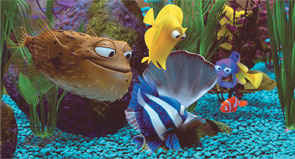
Now unveiled, Walt Disney & Pixar Animation Studio Films have donated a special exhibit of the 'Tank Gang' to the Melbourne Aquarium in conjunction with the release of Finding Nemo on DVD and Video.
In the movie, Nemo, a young clownfish is taken from his Great Barrier Reef home by a diver and is unwillingly relocated to a dentist's office aquarium. the aquarium is home to the 'Tank Gang', a diverse bunch of sea-life characters that soon become Nemo's allies, helping him in his quest to escape back to the ocean and to his father Marlin.
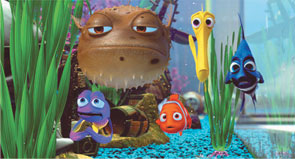
The exciting new exhibit, means that young and old alike can come face to face with a real clownfish and many more of the comical 'Tank Gang' in the film, such as Bloat, Bubbles, Deb, Gurgle, Jacques and Peach.
The aquarium has been designed and recreated in a unique television inspired aquarium. The newest attraction of the ' Tank Gang' have been replicated by the Melbourne Aquarium curatorial team. So come and see this fantastic new display at the Melbourne Aquarium, Cnr Queenswharf Rd and King Street Melbourne.
Finding Nemo is now available to own on DVD and video at all good stockists.
FACTS ABOUT NEMO & FRIENDS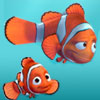 Nemo and MarlinCommon Name: Clownfish, Anemone fishSpecies Name: Amphiprion OcellarisHabitat: Indo-west pacific, North West Australia to Ryukyu Island, Malaysia, Singapore, Philippines. Most clownfish are found along coastal protected reefs, generally in shallow waters and usually in small groups near their favourite anemone.Biology: The clownfish is a protandrous fish, meaning they are born as males and become female if they are dominant fish. They have a symbiotic relationship with anemones. Clownfish lay eggs that the parents defend until they grow into juveniles. Usually bright orange colour, with three white bars and they can grow up to 90mm in length.
Nemo and MarlinCommon Name: Clownfish, Anemone fishSpecies Name: Amphiprion OcellarisHabitat: Indo-west pacific, North West Australia to Ryukyu Island, Malaysia, Singapore, Philippines. Most clownfish are found along coastal protected reefs, generally in shallow waters and usually in small groups near their favourite anemone.Biology: The clownfish is a protandrous fish, meaning they are born as males and become female if they are dominant fish. They have a symbiotic relationship with anemones. Clownfish lay eggs that the parents defend until they grow into juveniles. Usually bright orange colour, with three white bars and they can grow up to 90mm in length.
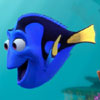 Dory
Dory
Common Name: Regal/Blue TangSpecies Name: Paracanthurus hepatusHabitat: Widespread throughout the Indo-Pacific, from east Africa to Japan and the Line Islands of south Hawaii.Biology: Juvenile Blue Tangs can be kept in groups, yet adults do better by themselves. They are more sociable than most other tangs but are also very susceptible to white spot infestations. Adults tend to lose their blue coloration in the belly area. The Blue Tang's stomach has a blade on each side and it also has venomous fin spines. The species grow up to 31cm in length.
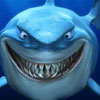 Bruce
Bruce
Common Name: Great White SharkSpecies Name: Carcharodon CarchariasHabitat: White Sharks are found near shores worldwide in temperate, coastal waters. In Australia they have been sighted from southern Queensland to north-western Australia.Biology: The body of the Great White Shark is rounded like a torpedo. It can be recognised by it's pointed snout, large pectoral and first dorsal fins, crescent-shaped tail, their black eyes and large serrated teeth. The Great White Shark usually has grey or bronze colourings on their top half, with white colourings underneath. They can grow in length to 6 metres and weigh 3 tonnes.
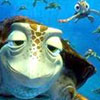 Crush and Squirt
Crush and Squirt
Common Name: Sea TurtleSpecies Name: ChelonidaeHabitat: The Green Turtle's habitat is all tropical and sub-tropical waters around the world including estuaries, lagoons and bays. In Australia, it is found from the northern coastal waters of Shark Bay in WA to Bundaberg, in QLD and also in the Great Barrier Reef.Biology: The Sea Turtle is an amphibian and lives approximately 15 to 20 years. Some can even live to be 80 years old. The Green Turtle usually has dark green or brown colourings on its upper surface with varying markings and they are usually lighter in colour underneath. Pregnant female sea turtles will come ashore, dig a pit in the sand on the beach and lay between 70-170 eggs. The babies will usually return to the same beach to hatch their own eggs.
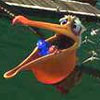 Nigel
Nigel
Common Name: PelicanSpecies Name: Pelecanus conspicillatusHabitat: Australia, Western Indonesia and Papua New Guinea are the countries that the Australian Pelican calls home, there have also been sightings in New Zealand and a number of western pacific islands. The species is often found around coastal inlands and shores in Australia and will also reside in marine areas, estuarine, freshwater wetlands and waterways including rivers, swamps and lakes.Biology: The pelican is easily recognised by its elongated bill and enormous throat pouch. the male is often larger than the female, as is their bill, which can measure up to 40-50 cm long. The species will normally feed alone however, a flock of pelicans (up to 1900) will work together and use their bills and beat their wings to direct they prey into a dense mass.
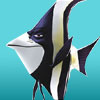 Gil
Gil
Common Name: Moorish IdolSpecies Name: Zanclus cornutusHabitat: Found widespread throughout the Indian-Pacific region, the Moorish Idol lives in both tropical and temperate waters in areas of rocky coasts and coral reefs. In Australia it inhabits the central Western Australian coast and the tropical north and south, right down to southern NSW.Biology: Growing up to 24-25cm in length, the Moorish Idol is a very social species. They often form pairs but sometimes they are seen as a single individual or occasionally in larger schools. the Moorish Idol's colours vary between yellow and white with two big black bands surrounded by blue. They have a very long, white, sickle-shaped dorsal fin, and above their snout they have a yellow saddle.
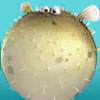 Bloat
Bloat
Common Name: BlowfishSpecies Name: Fugu of the family TestraodontidaeHabitat: There are close to 100 different species of Fugu worldwide, living in the tropical and subtropical parts of the Atlantic, Indian and Pacific Oceans, 38 species alone are found in Japan.Biology: The blowfish's ovaries, skin, muscles and liver can contain a deadly poison, similar to curare for which there is no known antidote. They grow up to 50cm long. The blow fish can puff themselves up because they have elastic skin and no ribs. When they become alarmed, a blowfish will puff itself up with water or air and make a squeaky noise to ward off intruders.
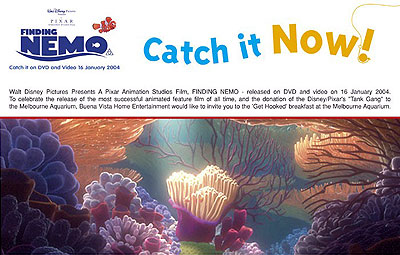
 Now unveiled, Walt Disney & Pixar Animation Studio Films have donated a special exhibit of the 'Tank Gang' to the Melbourne Aquarium in conjunction with the release of Finding Nemo on DVD and Video.
Now unveiled, Walt Disney & Pixar Animation Studio Films have donated a special exhibit of the 'Tank Gang' to the Melbourne Aquarium in conjunction with the release of Finding Nemo on DVD and Video. The exciting new exhibit, means that young and old alike can come face to face with a real clownfish and many more of the comical 'Tank Gang' in the film, such as Bloat, Bubbles, Deb, Gurgle, Jacques and Peach.
The exciting new exhibit, means that young and old alike can come face to face with a real clownfish and many more of the comical 'Tank Gang' in the film, such as Bloat, Bubbles, Deb, Gurgle, Jacques and Peach. Nemo and Marlin
Nemo and Marlin Dory
Dory Bruce
Bruce Crush and Squirt
Crush and Squirt Nigel
Nigel Gil
Gil Bloat
Bloat


